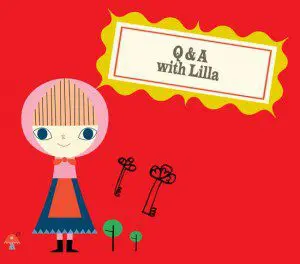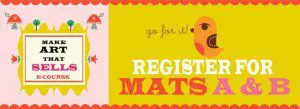Q&A with Lilla – Part 2 (from MATS A)

Our ‘Q&A with Lilla’ series is back! This is where we share questions from the previous class of Make Art That Sells.
In Lilla’s Make Art That Sells classes she often gets asked about how to sell work in particular markets, so we thought we’d share some of those questions and answers with you.
The next Make Art That Sells classes will start 2 March, 2015 and registration is open here.
You can see what a wide variety of topics are covered – and you might even find the answer to that burning question you have been wanting to ask! These questions were asked during the MATS Part A class last year.
***
Q. How much attention do you think your artist pay to ‘trend’?
A: Because we don’t live on Mars, for example, all of us are aware of trend to some degree, including even my hippest artists. The purpose of my course is point you in the right direction, so that, for example, you aren’t doing nude figures or still life for bolt fabric, just to give an example. Clients are all about looking at trends, buying trend reports, researching who is manufacturing what, so it’s real. That being said, know what’s out there and then lead the way with your own vision. If you understand the market and the consumer, then your vision is informed. I see so many submissions to me with subject matter, vibe, style, and color that I cannot sell.
Q. How much traditional art is actually licensed or used for commercial purposes? I am struggling with the idea of making art that makes us happy which is what you tell us to do, or doing something out of my comfort zone that may be more commercially viable.
A: That’s the million dollar question. Since we live in a commercial world, where if we want to make money with our art we need to sell it, but we also need to be true to ourselves so we don’t kill our soul, the how search is about finding the happy sweet spot where we love our work and yet it fits the needs of the buyers. This comes over time, as you make lots of pieces of art. Make all the kinds of work you like, and then watch as they meld together into something original AND marketable!
Q. Is there any stylistic difference between Retro and Vintage? Is one more marketable than the other?
A: Not really. Retro tends to mean mid-century, or a couple decades ago, and Vintage tends to be older, like earlier in the previous century.
Q. I have worked primarily in the fashion industry where it is very important to have multi-directional prints because they can turn the pattern pieces to fit more closely together so that there is less wasted fabric. I’ve been noticing the icons on many of the bolt fabrics you showed us in the MATS class were single direction prints. Is this something that is not as important in the bolt fabric industry?
A: You are correct. In my experience, this is not a factor, as the companies have great technical people that can and will do all that. They are looking for great style, ideas, colors, icons, etc.
Q. I feel that my style isn’t probably for the bolt fabric market. I usually don’t use a lot of different icons in my design and like simple design styles like Marimekko and Orla Kiely. Is there still a market for me if my style is so different from the ones you show in the class.
A: I love those looks, too. However, to my knowledge, they are done in house. That’s why I show the work I do. But look at fabric sites and see if you can find work you relate to.
Q. Does 8 colours on Illustrator/Photoshop include tonal variations of the same colour?
A: Yes, generally every color counts.
Q. In your interview with Crate N Barrel, you asked how they like to be approached. It sounded like email is not the best approach for an artist that they haven’t worked with before. With your experience, what have you found to be a good approach for an artist to present work to a Home Decor company?
A: We have a relationship with Crate, so we send ideas and images to them all the time. A company like Crate is in huge demand, so it’s difficult to get into. I know that they judged our Global Talent Search so that approach may work there, for example. Also, they are always on the lookout for new artists, so start with other companies that you can submit to, build up your business, and see what happens.
Q. I am always wary about putting my art on my website, especially the art I have product ideas for. I do post images with watermarks and at 72dpi but it doesn’t stop people from downloading that image and using it. In your experience, what do you recommend to help protect your artwork?
A: One must show work to get work. I advise that you show plenty of work on your site and in various social media channels, but also have a password-protected gallery of some of your work for your best clients. There is a downside to everything. If you never showed your work, you’d never get work. If you see someone copying your work, you can write them a cease and desist letter, or require them to pay a fee, or if the work is already licensed, notify your client and they may go after the copier in question. If in doubt seek professional advice from an intellectual property lawyer or an organization like ACID (Anti-Copying in Design).
***
Got your own questions for Lilla? Join us for the next round of Make Art That Sells. Class begins on Monday 2 March, 2015 and registration is open here.





Well worth the read. Thanks for sharing the Q&A Lilla. I always learn something new.
Thank so much for posting these Q&A’s – every bit of Lilla advice helps me to be more savvy in my approach.
You always have such great info….thank you.
Lilla, I found this Q & A very enlightening, thank you for the valuable advice.
Many thanks!